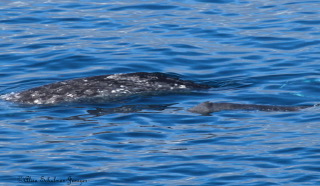

Gray Whale Census morning crew M’Liz Callender, Petrina Long, Joanne Kajiyama, and Caroline DeGraaf, 2024 February 29, Point Vicente Interpretie Center, by Alisa Schulman-Janiger.
Southbound gray whale mom and calf, photographed from our Census station at the Point Vicente Interpretive Center; 2024 January 18, by Alisa Schulman-Janiger.
Gray Whale Census update, for the March 2024 Spyhopper, by Gray Whale Census Director Alisa Schulman-Janiger
Photo of Alisa Shulman-Janiger above taken by Gray Whale Census observer Sarah Ford
Our 40th consecutive full season of the ACS/LA Gray Whale Census and Behavior Project started on 1 December 2023, from the back patio of the Point Vicente Interpretive Center (PVIC) on the Palos Verdes Peninsula). About 100 citizen scientists (trained volunteers who watch from sunrise to sunset in daily shifts) spot, count, track, and record behaviors and other data on Pacific gray whales as they migrate past our observation post, as well as identify and record other marine mammals that transit our viewing field.
We counted 217 southbound gray whales (including 22 newborn calves), and 199 northbound gray whales (including 4 calves) from 1 December 2023 through 4 March 2023. (Last season to date, we had counted 288 southbound grays – including 35 calves – and 104 northbound grays). Our southbound migration started later than usual again, with lower counts than in recent years. We will be setting a new record low southbound gray whale count, breaking last season’s record low of 293; previous seasons’ southbound counts have varied from 301-1902. Our gray whale count during the peak week for our southbound migration was higher this season: 68 southbound grays (19-24 January), compared to 58 last season. Our highest daily count was very low again: 16 southbound grays (on 18 January), our second lowest peak southbound count. The crossover period was very long, with few whales going in either direction (a more typical “gap” season), as the migration phase shifted from primarily southbound to primarily northbound. This vacillated back and forth between 5 January and 18 February, with our official turnaround date set at 21 February – one day earlier than last season, and right after we had been closed for two days (due to heavy rains). We spotted 34 northbound grays during our southbound migration phase. Our highest northbound count to date was on 3 March, with 28 northbound grays; our peak northbound counts always occur in March. Weather conditions such as rain, wind, and fog have severely impacted our counts; we closed on 6 days due to heavy rains and flooding/mudslides, as these conditions seriously challenge our abilities to find and track whales.
Other marine mammal species sighted: fin whales, humpback whales, minke whales, a pair of sei or Bryde’s whales (first time we have spotted either species from our Gray Whale Census), killer whales (Eastern Tropical Pacific “ETPs” from Mexico, who killed our first southbound gray whale calf in January); common dolphin, coastal and offshore bottlenose dolphin, Pacific white-sided dolphin, Risso’s dolphin, California sea lions, and harbor seals.

